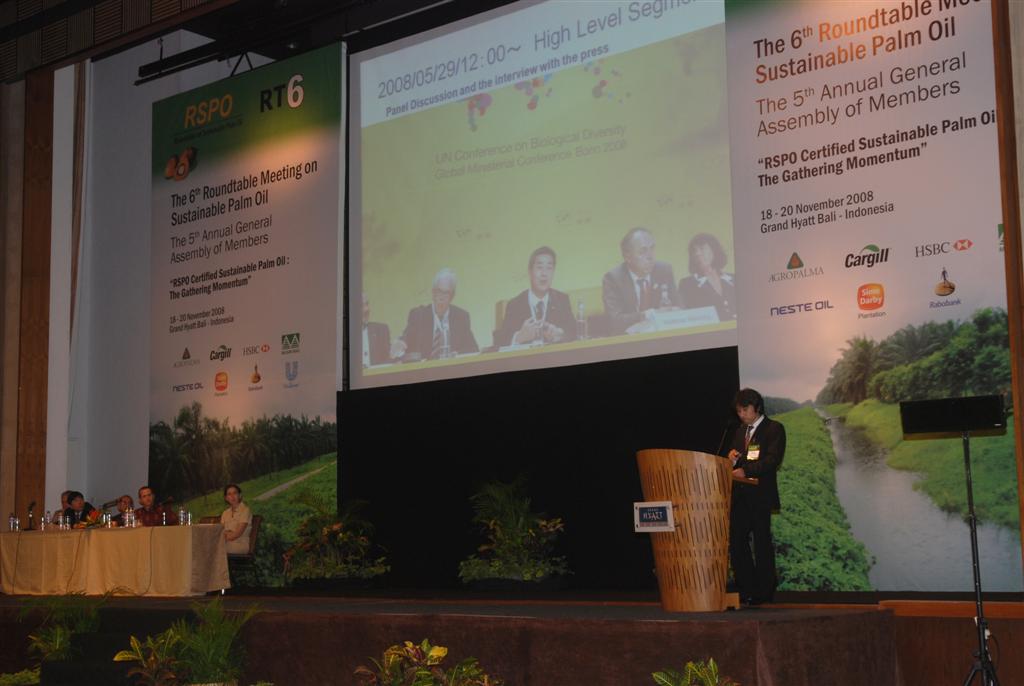SDGs Interviews: Talking Life on Land with Nobuo Nakanishi

SARAYA is one of Japan’s leading companies that implement the United Nations Sustainable Development Goals (SDGs). This is the fourth chapter of SARAYA’s SDGs interview series telling the story of those behind SARAYA and how they are working to achieve these goals. In this edition, we spotlight Nobuo Nakanishi, Researcher of SARAYA. Here is his story, and his approach to SDG №15: Life on Land.
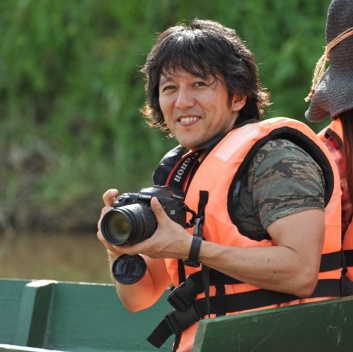 |
|
How did you come to work at SARAYA?
I joined SARAYA as a researcher in 2004.
I was a graduate student at Osaka University School of Human Sciences studying international cooperation and was referred to SARAYA by my professor. In August 2004, Mr. Saraya, the president of SARAYA, learned of the biodiversity crisis of Borneo, Malaysia while being interviewed on a television show called “Wonderful Spaceship Earth”, an environmental documentary series, on a chapter centered around baby elephants wounded by human traps. Palm oil plantations were causing great damage in the fauna, destroying habitats, and SARAYA, although just one of many companies using palm oil, received many complaints despite being the only one that didn’t refuse to appear in the program.
They immediately started to seek solutions, looking for someone who could do research and come up with suggestions. I was appointed to that role and flew to Malaysia to research, helping them to establish two non-government organizations, the Borneo Conservation Trust (BCT) in Malaysia and the Borneo Conservation Trust Japan (BCTJ) in Japan. Ever since I have been involved with BCT’s Green Corridor Projects, buying pieces of land to conserve the wildlife in Borneo while I work as a researcher for SARAYA.
I also did research in Uganda before SARAYA started a hygiene business there and helped establish the company. SARAYA is a unique company that realizes its corporate social responsibilities by taking part in many good causes in various parts of the world.
I am happy and honored that I have this unique position as a researcher at SARAYA and able to contribute to the world through my work.
What did you do before joining SARAYA?
I was born into a family of dentists spanning four generations in Osaka, and as my family expected, I also became a dentist in 1984. At the same time, I kept a strong desire to travel to exotic lands. Since very young, I liked to read books about traveling, anthropology and overseas reports and knowing how people lived in different countries fascinated me. My first trip abroad was to New York when I graduated from university, but my turning point came when I visited India by myself in 1986.
After working as a dentist for 2 years, I got 10 days off and flew to India. I visited Delhi, Varanasi, and Calcutta (now Kolkata) staying at cheap hostels. I was overwhelmed by the hustle and bustle of the city, the smell of spices and incense, and many people living on the streets. At hostels, I met many world-traveling backpackers, some traveling the world for years. I was amazed to know that their minds were so free. I started to wonder about the traditional Japanese values of living to work without detours. It was then when I decided to travel for life.
As soon as I returned to Japan, I went back to work as a dentist and started a plan to travel the world, collecting travel information, and studying languages. In 1987, 2 years after my India trip, I arranged for my friend to take over my dental clinic, moved out of my apartment, removed my resident registration card and took off. My girlfriend, who later became my wife, quit her job at a trading company and joined me.
Our original travel plan was going from England to India through land, based on Kotaro Sawaki’s "Midnight Express", a very popular travel journal of his bus trip from Delhi to London, which inspired many Japanese youths including me at that time.
Since then, we made backpacker trips through Europe, Asia, Latin America, and Africa, taking a couple of years each time. Every time I ran out of money, I came back to Japan and worked as a dentist.
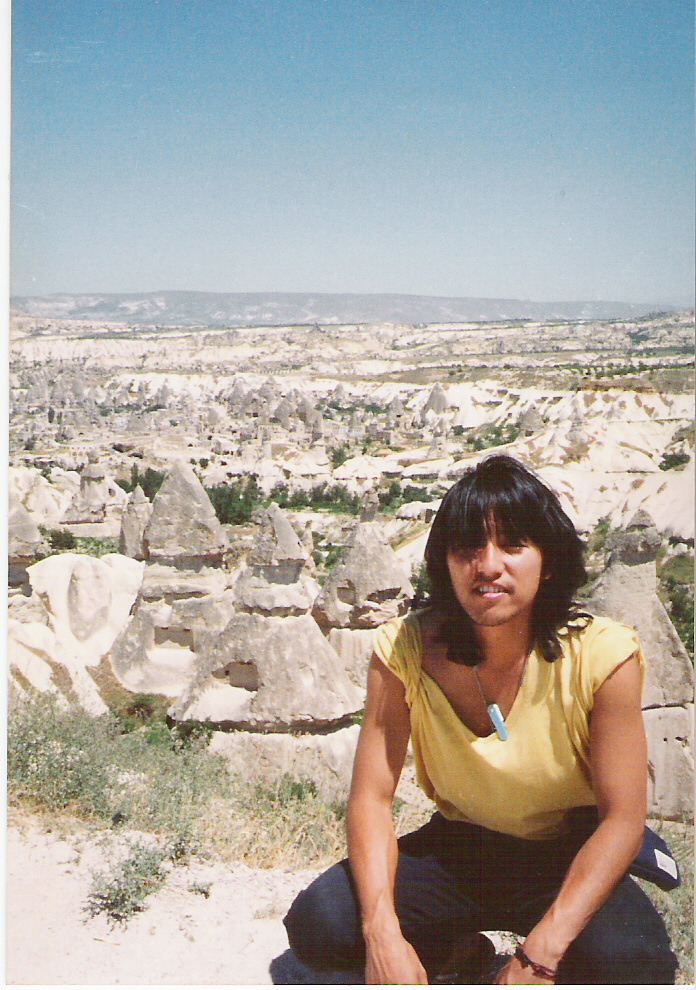
Some of the most memorable moments were in Iran during the time of the Iran-Iraq War. It was surprising to know that we could enter a wartime country without a visa and that people lived normal lives on the outskirts of warzones. Sometimes people were so kind that they let us stay at their homes. I learned that the media covers only some parts of the facts.
When we were traveling in Indonesia, I realized that I did not feel the same excitement as before. That made me think about going back to school to study to become an anthropologist and make traveling a profession.
What was it like to go back to school after years of traveling?
In 1996, I entered the Doshisha University majoring in sociolinguistics, the study of language in relation to social factors, including differences in regionality, class, occupational dialect, gender differences, and bilingualism. It’s close to anthropology but focuses more on the usages of languages depending on social variables like ethnicity, religion, status, gender, etc. I thought that language was the most important tool when trying to understand the inner feelings and thinking processes of others. There, I met Professor Osamu Ono who inspired me with all his experiences. He was a literature professor as well as one of the founders of the Nippon International Cooperation for Community Development (NICCO), a Japanese NGO which supports self-reliance among people in developing countries in Asia, the Middle East and Africa.
When I was about to graduate and getting ready to do my master’s degree in Cairo, Egypt, he told me that NICCO was looking for a project manager for an environmental conservation agriculture extension with a microfinance project in Jordan. I told him that I could hardly speak Arabic. He said, “If you want to change your life, you have to fly.” I slept on it and decided to go to the Middle East, becoming the first paying job I took which allowed me to travel.
How was being a project manager of an NGO in Jordan?
My job as a project manager was to promote the method of environmental conservation type agriculture known as permaculture, to make a model farm locally and to provide training for residents, aiming to add value to the products by using environmentally friendly farming methods while improving the lives of local residents. It came with microfinance projects, providing loans for various purposes like the local customary farming method, sewing, beekeeping, etc.
I set up an office with the help of the residents in Joufa, a village about an hour’s drive away from Amman, the capital of Jordan, and one of the world's lowest villages at 400 meters below sea level. Developed from a refugee camp for Palestinians, its inhabitants are mainly second and third-generation refugees.
It was my first time to be involved with "environmental conservation", learning a lot. It was also my first experience working with foreign staff, with a good team that made the project run well. I completed my term in 2003, but the project still continues to this day, still keeping in touch with some of them.

How did you get involved with the BCT (Borneo Conservation Trust)?
While I lived in Jordan, some young Japanese people came and stayed with us. Through some of them that studied international cooperation, I learned about Dr. Yasuhide Nakamura, a professor at Osaka University, renowned pediatrician who was involved with many achievements in medical international cooperation projects. I thought he may be the right person to guide me in my career, so I went to see him right after I came back from Jordan. I ended up going to Osaka University Graduate School to study international cooperation under him in 2004.
Around that time, Professor Nakamura asked if I wanted to research Borneo.
Prof. Nakamura’s high school friend, the president of SARAYA, was about to start a project related to the environmental crisis in Borneo. He suggested that I write a thesis and help them. Although I have always been interested in Asia, this challenge just fell upon me despite having no prior connection. Realizing that I could get paid for my research, I couldn’t find any reason to decline, so I went to the company for an interview and got hired as a researcher.
Could you explain how the BCT (Borneo Conservation Trust) started?
To explain the situation in more detail, there was a Japanese TV program called "Wonderful Spaceship Earth – The Tears of Baby Elephants” filmed in Borneo in 2004. The producer who is a renowned animal journalist, meant to shoot the not-so-well-known Borneo elephants, an endemic species to Borneo and introduce them to Japan, but while filming in Borneo early 2004, she saw many wounded wild elephants from a type of trap called the "rope snare" set by humans.
 Rope incrusted in the skin of the elephant due to rope snare.
Rope incrusted in the skin of the elephant due to rope snare.
The region of Sabah, Borneo, Malaysia, is a treasure trove of biodiversity, but it has an expanding large-scale oil palm plantation industry trying to meet the growing palm oil demand in the world, causing the loss of animal habitats as a side-result. Most of the workers employed on the farms were immigrants or illegal immigrants from abroad, often poor and lacking food, that used traps to catch small animals such as wild boars and deer as a protein source. Elephants were not the target of hunting, but child elephants are curious about such gimmicky traps and tend to bring their feet and nose too close. Once you get entangled, those ropes made of plastic won't come out. While small animals are caught as they are, elephants tear them off and return to the forest while part of the rope remains entangled and bites into the skin as they grow. The TV crew witnessed a lot of elephants draining pus from their noses and feet and learned that the cause was the development of oil palm plantations, including the ones that export to Japan. Palm oil is used in our food and detergents, and we consume it without knowing it.
The producer thought that interviewing manufacturers that use palm oil as a raw material was indispensable to complete the program, so they contacted several food companies, but all refused. At the time, she approached Mr. Gunter Pauli, a friend of President Saraya, who told her that Mr. Saraya may accept the invitation as he was quite understanding.
The TV show was completed with the interview of President Saraya and broadcasted in Japan in June 2004. In the interview, the president answered with an honest "I didn't know this was happening", however, the viewers were concerned that SARAYA's products were involved in the environmental destruction of Borneo, resulting in complaint calls and callings for a SARAYA product boycott. President Saraya felt a sense of crisis and decided to take action immediately, asking advice from his friend Professor Yasuhide Nakamura, my professor, who is familiar with support activities in developing countries. At the same time, the program producer was confused by the excessive reaction of the viewers. As they knew that President Saraya was taking action immediately, they decided to make a sequel to the program, adding how SARAYA was standing up to the problem.
The highlight of the sequel was the wounded elephant rescue project initiated by the Malaysian Department of Wildlife and the RSPO (Roundtable on Sustainable Palm Oil), a new organization that started to transform the market towards sustainable palm oil. They started to film at the end of 2004, me acting as SARAYA’s representative communicator between our TV crew and the local people, finishing the filming in January 2005. The rescue programs to take in wounded elephants and surgically remove the rope bitten into their bodies were successful, but it is not a solution by itself. Thus, this paved the way to establish the Borneo Conservation Trust in Malaysia and the Borneo Conservation Trust Japan.
In February after the TV crew left, I started to research on my own, gathering information on what SARAYA should do for Borneo’s future. I first asked JICA (Japan International Cooperation Agency) for help since they helped me with my project in Jordan, contacting Professor Nakamura, a well-known expert in the organization, to write a referral letter to visit the local JICA office to research various project sites in Sabah, Borneo. At that time, JICA was implementing a project called Borneo Biodiversity and Ecosystem Conservation Program (BBEC).
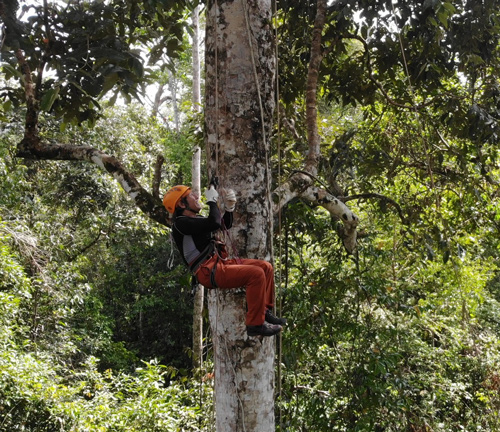
Through the BBEC chief program advisor, I met a Japanese expert named Toshinori Tsubouchi, who later became the director of BCT. He was passionate about conservation and social change and connected me with important people like the director of the Sabah Wildlife Department, JICA experts, and local people in charge. After returning to Japan, Mr. Saraya met Mr. Tsubouchi and we started to work on the establishment of the current BCT and BCTJ programs.
I also have to mention Dr. Isabelle Lackman, another important researcher when I visited the Kinabatangan district with our TV crew. A French primatologist who has been a researcher of orangutans since the 1990s, she lived in a village near the Kinabatangan River in Sabah and has been engaged in orangutan research and conservation activities. She later also became a key person in our orangutan suspension bridge project, the hornbill conservation project, and the early green corridor project that she is currently implementing.
What is the Green Corridor Project? What else does BCT do?
The Green Corridor Project is where we establish biodiversity conservation by connecting fragmented and shrunken forests around the Kinabatangan River in Sabah, Borneo, by purchasing through the BCT land from farmers and residents. My main job is to run the trust, considered one of the National Trust movements, with SARAYA donating 1% of some of their product sales to the BCT.
The main activities of BCTJ are to raise awareness and funding in Japan while BCT executes environmental conservation programs such as the mentioned before. In addition to trust activities, BCT and BCTJ also have emergency projects such as elephant rescue projects and hornbill conservation projects as needed.
Another important project is the Orangutan suspension bridge project. Orangutans, the flagship species of Borneo's biodiversity, are thought to remain trapped in shrinking forests in some areas but they can’t swim in the river to move to better environments as other monkey species do. A local NGO came up with this suspension bridge project that wasn’t successful at the start, but after the BCTJ proposed a friendlier bridge using recycled fire hoses from Japan built with the cooperation of zoo personnel, we got proof of orangutans using them on camera only two years later.
What is your current role at SARAYA?
Apart from helping in running the trust I work granting applications and gathering information for future projects, and organize project site tours that I attend annually. The tour includes visiting the project site, explaining the local situation and meeting with local people, guiding journalists to local project sites sponsored by the Ministry of the Environment of Japan, and realizing in-house site tours. At the same time, I have also been in charge of the hornbill conservation project, going into the field with volunteers and developing the project along with local residents and researchers.
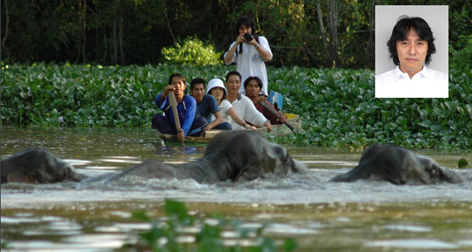
Recently, we conducted a survey on civic group activities of the Indonesian side of Borneo, where we would like to expand our programs. The source of palm oil for Saraya was mostly from Malaysia in the beginning, but the amount of raw material coming from Indonesia is now increasing, so it’s vital that we are responsible for its use, one of the SDGs points.
Lastly, I am also involved in work related to the RSPO certification, attending the RSPO Annual General Meeting, proposing sustainable palm oil production to the oil palm industry and exchanging information with RSPO members.
While in Japan, we mainly conduct educational activities and lectures on sustainable palm oil production for various events and study sessions, bringing awareness to companies and organizations. I am often asked to give lectures about SARAYA’s activities in Uganda and Borneo at various schools including universities, and as part of the Borneo Conservation Trust Japan, I organize regular meetings with volunteer members in the Kansai region, expanding the circle of activities every month since 2007, reaching a number of volunteers that has become a major force in conducting events.
SARAYA won numerous awards in conjunction with these environmental activities including “The Asahi Corporate Citizen Award” by Asahi Shimbun Newspaper, a major Japanese national newspaper, for the rescue and biodiversity conservation projects in Borneo in 2006 and the Biodiversity Action Award by Japan Committee for United Nations Decades of Biodiversity in 2016.
We hope our network impacts the next generation and takes over our projects in order to build a better society.
Please give a message to the next generation
There are so many things I don't understand.
Human populations are increasing. Would it be better that we increase further and start going to space? Or is it better that we all disappear from this earth? Or should we just move on bit by bit? Nobody knows what’s good or what’s bad.
Whatever will be will be.
After saying that you may wonder, why have I been involved in biodiversity conservation activities for 15 years? And in a place called Borneo?
The answer is simply because there aren't many interesting things like it.
Through these projects, I have seen a lot of drama among people. A week after I witnessed some drama in Japan, I would again witness a similar but slightly different drama in a city in Malaysia, and then in a village in Borneo, where there is no gas, no water nor electricity. Isn’t the last one a bit more interesting?
At the same time, you can see the drama happening in the world of mammals, insects, and plants side by side with the drama of humans. Sometimes humans look great, but sometimes they look more stupid than insects. There are moments when you realize that you are controlled by plants, and If you go deep into the forest, you'll be bullied by the nature you're trying to protect, and in a really damaging way. Thrill, suspense, and horror aren't stories across the screen anymore. What a thrill I had when I came across some angry elephants and got away by chance! Sometimes nature is really scary, and you become the hero of your own story.
If there were no forests, if culture were all the same, if capitalism existed in every corner of the world, then we'll only witness the same problems. If you could only enjoy this special experience through the screen or VR goggles... that would be so boring! That’s why I protect the rainforests of Borneo and its biodiversity.
“Ah, you're doing it for your own fun, not for the sake of humanity or the next generation…” Some may say. I would say, “Of course, it is a major premise that it is for the next generation and humanity, but yes, I am doing it because I am having fun.” There is no better motivation.
The more fun, the more people. When we have more people, we start a trend. I hope more people will join this trend of fun. That’s my mission.
I hope you can all join me in having fun protecting the rainforests and preserving biodiversity!
